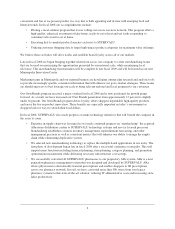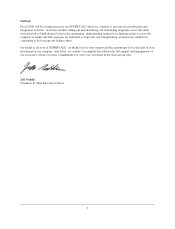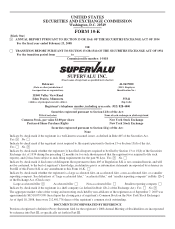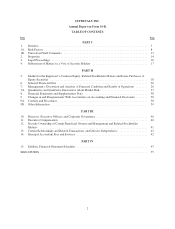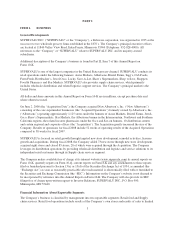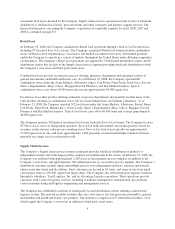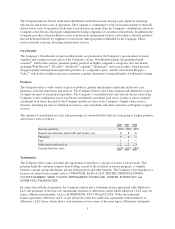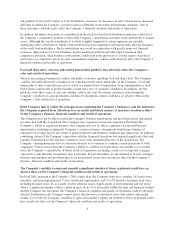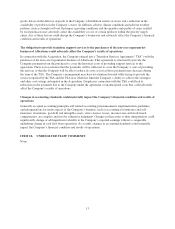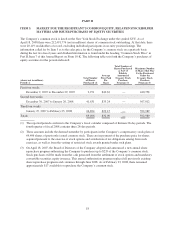Albertsons 2008 Annual Report Download - page 14
Download and view the complete annual report
Please find page 14 of the 2008 Albertsons annual report below. You can navigate through the pages in the report by either clicking on the pages listed below, or by using the keyword search tool below to find specific information within the annual report.The term of office of each executive officer is from one annual meeting of the Board of Directors until the next
annual meeting of Board of Directors or until a successor is elected. There are no arrangements or understandings
between any executive officer of the Company and any other person pursuant to which any executive officer was
selected as an officer of the Company. There are no family relationships between or among any of the executive
officers of the Company.
Each of the executive officers of the Company has been in the employ of the Company or its subsidiaries for
more than five consecutive years, except for Duncan C. Mac Naughton, Kevin H. Tripp, Peter J. Van Helden,
Paul L. Singer and Adrian J. Downes.
ITEM 1A. RISK FACTORS
Various risks and uncertainties could affect the Company’s business. Any of the risks described below or
elsewhere in this Annual Report on Form 10-K or the Company’s other SEC filings could have a material impact
on the Company’s business, financial condition or results of operations.
General economic conditions, including increases in energy and commodity prices, that are largely out of
the Company’s control may adversely affect the Company’s financial condition and results of operations.
The Company’s Retail food and Supply chain services businesses are sensitive to changes in general economic
conditions, both nationally and locally. Recessionary economic cycles, higher interest rates, higher fuel and other
energy costs, inflation, increases in commodity prices, higher levels of unemployment, higher consumer debt
levels, higher tax rates and other changes in tax laws or other economic factors that may affect consumer
spending or buying habits could adversely affect the demand for products the Company sells in its stores or
distributes to its retail customers. In addition, the Company could experience reduced traffic in its stores or stores
that it supplies, or limitations on the prices the Company can charge for its products, either of which could reduce
the Company’s sales and profit margins and have a material adverse affect on the Company’s financial condition
and results of operations. Also, economic factors such as those listed above and increased transportation costs,
inflation, higher costs of labor, insurance and healthcare, and changes in other laws and regulations may increase
the Company’s cost of sales and the Company’s operating, selling, general and administrative expenses, and
otherwise adversely affect the financial condition and results of operations of the Company’s Retail food and
Supply chain services businesses.
The Company faces a high level of competition in the Retail food and Supply chain services businesses,
which could adversely affect the Company’s financial condition and results of operations.
The industries in which the Company operates are extremely competitive with narrow profit margins. The
Company’s Retail food business faces competition for customers, employees, store sites, products and other
important areas from traditional grocery retailers, including regional and national chains and independent food
store operators, and non-traditional retailers, such as supercenters, membership warehouse clubs, combination
food and pharmacy stores, limited assortment food stores, specialty supermarkets, drug stores, discount stores,
dollar stores, convenience stores and restaurants. The Company’s ability to attract customers in this business is
dependent, in large part, upon a combination of product price, quality, assortment, brand recognition, store
location, in-store marketing and design, promotional strategies and continued growth into new markets. The
Company’s Supply chain services business is primarily wholesale distribution and includes a third-party logistics
component. The distribution component of the Company’s Supply chain services business competes with
traditional grocery wholesalers on the basis of product price, quality, assortment, schedule and reliability of
deliveries, service fees and distribution facility locations. The third-party logistics component of the Company’s
Supply chain services business competes nationwide in a highly fragmented marketplace with a number of large
international and domestic companies and many smaller, regional companies on the basis of warehousing and
transportation logistics expertise, cost and the ability to offer asset and non-asset based solutions and design and
manage customer supply chains. Competitive pressures on the Company’s Retail food and Supply chain services
businesses may cause the Company to experience: (i) reductions in the prices at which the Company is able to
8


